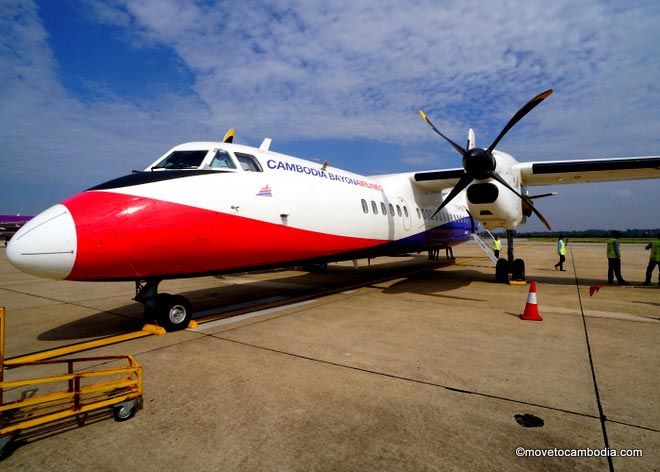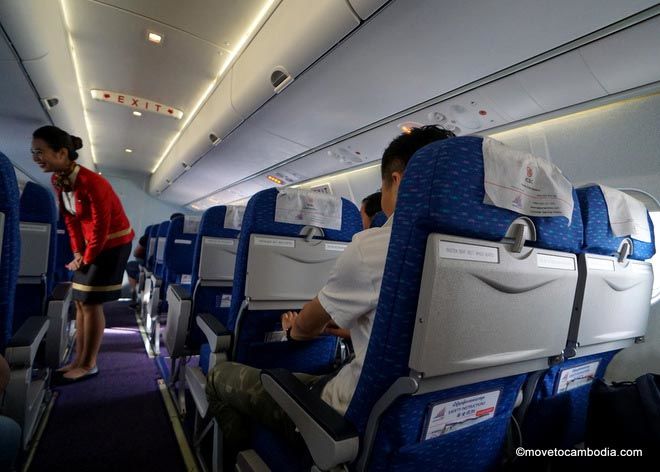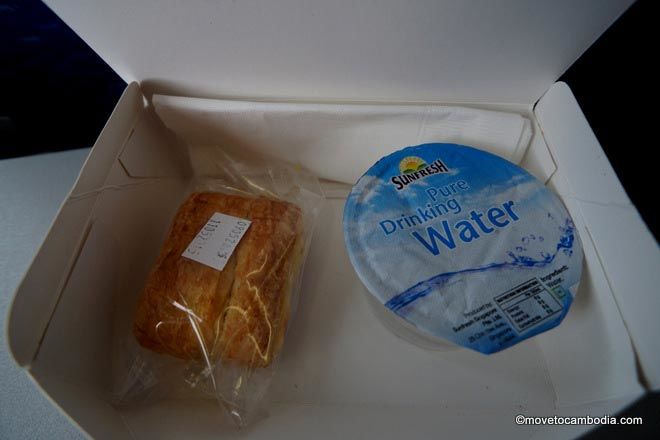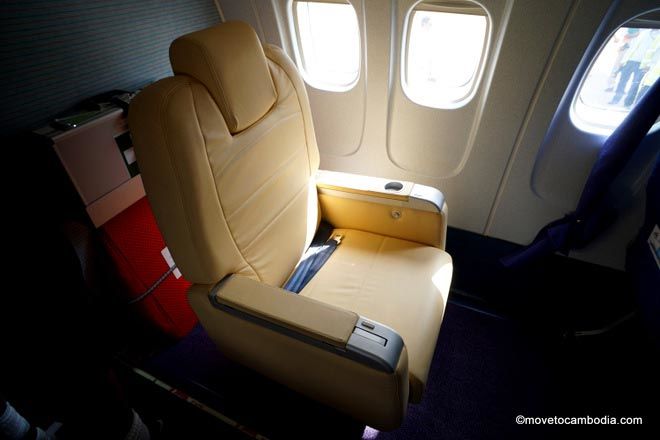Yet another Chinese entrant into Cambodian domestic airspace, Cambodia Bayon Airlines flies between Phnom Penh and Siem Reap, Siem Reap and Sihanoukville, and Phnom Penh and Sihanoukville. Flights are incredibly cheap, but there are some serious safety concerns to consider. We fly Cambodia Bayon Airlines from Phnom Penh to Siem Reap and see what all of the fuss is about.

Cambodia Bayon Airlines flies Chinese MA60 turboprop planes. Be ready for a loud ride.
Cambodia Bayon Airlines is Chinese-owned, partially by Joy Air who unsurprisingly chose not to operate under their original name, which sounds exceedingly crude in the Khmer language. They’re flying one MA60, a Soviet-style turboprop plane, that covers all of the three routes each day, but they’re planning to expand their fleet and presumably dominate the Cambodian domestic market with flights between Phnom Penh and Siem Reap every 45 minutes.
The MA60 (“Modern Ark 60”) is a Chinese-made plan with a troubled history. Because of numerous crashes, accidents, and safety concerns, the plane has been banned from flying in the US, Europe, UK, New Zealand, and Australia. Recently, countries like Tonga, Nepal, and Indonesia have either gotten rid of or banned the MA60 due to safety issues. Cambodia Bayon Airlines, on the other hand, has 19 more on order, which will eventually make them one of the airlines in the world with the largest number of these exotic, if dangerous, planes (only beaten by the aptly named Okay Airlines).

Economy class on Cambodia Bayon Air…not as bad as you might expect.
Now here’s where I digress into the stuff that you might not care about, but Bayon Air purchased the 20 planes at a cost of $450 million from Chinese state-owned aerospace company Aviation Industry Corporation of China (AVIC). But according to the Phnom Penh Post, “Bayon Air is a subsidiary of Bayon Holding Limited, which is wholly owned by AVIC and China Easter Air’s Joy Air.” So yes, a company is purchasing millions of dollars in unsafe planes from itself to operate in Cambodian airspace.
Of course I was completely unaware of any of this when I booked the morning Bayon Air flight from Phnom Penh to Siem Reap. And it was fine; I survived the flight. The flight took about 50 minutes, which is longer than Bassaka Air, because it’s a smaller plane. The noise near the propellers is pretty loud, and there’s no room for any large or awkward luggage in the overhead bins. Perhaps knowing these failings, Bayon Air bribes its passengers by handing out pastries and water during the flight.

The pastry bribe: not bad for a 50-minute flight.
I was told that check-in closes 30 minutes before the flight takes off (and boarding starts at the same time). Like the other domestic airlines, Bayon Airlines is relatively lax with ID requirements and will accept a photocopy of your passport in lieu of the real thing. I also noticed the security screener ignoring the screen, making me wish I hadn’t chucked my bottle of water.
The Bayon Airlines MA60 have 50 seats. 48 of those are regular economy seats, but the other two appear to be two random easy chairs in the back of the plane (which is where the passengers board) that makes up the whole of business class.
On the Phnom Penh to Siem Reap route, prices start at $32 for a one-way once taxes are included and a preposterous $153 for business class. The Phnom Penh to Sihanoukville route seems to be hovering around $70 (and $169 for biz). This route is especially silly, because it flies from Phnom Penh to Siem Reap to Sihanoukville, which takes almost three hours. If you hit the gas, you can drive it in the same amount of time, so the plane is probably not the best way to get from Phnom Penh to Siem Reap. If you’re flying Siem Reap to Sihanoukville, flights are currently starting around $54 for a one-way ticket.

The exceedingly odd solo business class seat. There’s one more across the aisle.
Overall, I probably won’t be spending a lot of time flying on Cambodia Bayon Air because of safety concerns, but I also recognize that I’m probably more likely to die on Cambodia’s roads than I will in its skies, no matter how often I fly.
Bayon Airlines schedule:
Phnom Penh to Siem Reap: 8:10 a.m.
Siem Reap to Phnom Penh: 8:00 p.m.
Phnom Penh to Sihanoukville: 4:20 p.m.
Sihanoukville to Phnom Penh: 3:00 p.m.
Sihanoukville to Siem Reap: 5:35 p.m.
Siem Reap to Sihanoukville: 9:55 a.m.
At the time of writing, Bayon Air is flying daily trips between Phnom Penh and Siem Reap, Siem Reap and Sihanoukville and Phnom Penh and Sihanoukville (with a triangle flight). It’s best to check and confirm, as they change their schedule regularly. I’d recommend not booking too far in advance or relying on them to connect to an international flight. With only one plane, if they have any mechanical failures the flights for the day will inevitably be cancelled.
Tickets can be booked with most travel agents in Cambodia, or tickets can be reserved on the Cambodia Bayon Airlines website, and then paid for within 24 hours at their office in Phnom Penh, Siem Reap, or Sihanoukville. They will also, allegedly, send someone to you to pick up payment in either of those cities while they work on getting their payment processing set up.
Want to compare all of the airlines flying between Phnom Penh and Siem Reap? Read the Phnom Penh-Siem Reap flights blog post.
Cambodia Bayon Airlines
Phnom Penh International Airport, Phnom Penh
Borei Angkor Arcade Shopping Center, Road 6, Siem Reap
T: 023 231 555; 099 227 301
bayonairlines.com
I am an airline pilot, I fly the MA60 & have done since 2014.
I have almost 1000 hrs on Type.
No major problems
malo from Tonga :)
I thought they grounded them in Tonga, are they flying again? Why do you think the MA60 has such a bad reputation if there’s no problem? Is it just issues with the pilots at these airlines?
Hi Lina,
I am a little late in joining this conversation apparently, but I am completely backing Richard’s comments on the MA60. Granted this aircraft has had bad press, but surely for all the wrong reasons. It’s an incredibly tough aircraft and his rusticity is adapted to fly under those latitudes. Out of the 13 accidents that have involved this plane, only 1 has resulted in casualties. Naturally, that’s 1 too much, but as stated by Richard, training standards or weather conditions were to blame rather than aircraft specifications. Most equipment on-board are indeed from western origins and Bayon Airlines history is accident-free so far. As a blog taking pride in informing the traveling public, I think it is important not to spread a distorted view of the reality and potentially harm the reputation of businesses without fact-based evidences… Bayon Airlines commercial reliability might be debatable as reported by some of the contributors here (which is often the case with young airlines), however that doesn’t constitute a safety concern. That being said, well done for your blog and keep… flying high!
Thanks for your comment. Personally, I don’t think I’m spreading a distorted view of reality, because the safety of this plane is very controversial. The Wall Street Journal investigated a few months ago and found some very concerning things.
China also does not release all of their domestic accident information, so there may well be more than 13 accidents. And 13 accidents when there are only 53 planes in operation seems like a lot to me. Compare that rate to the to the ATR-72, a similar plane, or the Airbus 320 family which is the other option to fly in Cambodia. And while I can believe that some of the MA60 accidents are due to user error, that doesn’t negate the stats listed above from the Wall Street Journal.
Out of curiosity, are you by any chance affiliated with an airline?
DON’T BOOK any flight with BAYON AIRLINES.
I was struggling to reach them, and I have never been noticed that they CANCELED my flight, I had to call them to hear that one week before my flight !!! I AM REALLY ANGRY AT THEM
THIS COMPANY IS UNRELIABLE and SCAMMER !
Thanks for the info Thibert.
I was booked to fly on the 11-20 am flight from phnom phen to Hoi Chi Ming city (Singapore ) On the 24th of January. The flight was cancelled, no offer of an explanation let alone an apology, or more importantly a solution!!!!!!
We flew from SR to PP on 20 jan 2016. Everything was efficient, from booking through to the flight itself, which departed on time and landed ahead of schedule. While I cannot comment on the crew’s competence, they all appeared to know what they were doing. My only complaint is that the taxes and charges made up a hefty 60% of the fare, and these only become obvious late in the booking process.
Airport taxes fuel surcharges etc. etc. can easily do that. Try a $19 promtion fare on Cambodia Angkor Air, REP to BKK which ends up being $80 with no extra charge for baggage or seat selection as with Air Asia. Part of life I guess. Tax Tax Tax
Dear Richard and Lina,
Regarding the accident statistics of MA60 is clear that 5-10% of the aircraft type has been damaged or writen off because of an accident. I dont think these Source: https://en.wikipedia.org/wiki/Xian_MA60
This is a crazy number and shows that there is a real, serious concerns of the safety of MA60. Also, the MA60 is not currently in operation in Tonga, and its not certified to us either in EU or in USA which gives strongh indication about the doubts that the authorities have.
This reminds me of flying with Yeti Airlines in Nepal, 36 seat airplane, over the Himalayas :) Not the most convenient type of travel but definitely adventurous and cheap, too.
Nice blog you got there, Lina, keep it up!
Thanks for the investigations into the MA60 aircraft. If nations like Tonga, Nepal etc… are shedding these aircraft, I think I’ll try Bassaka Air first.
True and I’d always question any aircraft that is not certified to fly in EU or US airspace.
Actually if we talk about Nepal, its an extra case, since in the world only few pilots are having license to fly to Nepal due to the geography situation (lot of high mountains)!!
I’m usually not short on words but ummmmmmmmmmm why bother.
I fly them so you don’t have to, Vincent ;)
Ha Ha well I’ll remember you in my prayers
Hi Lina,
You clearly don’t know much about aviation and clearly even less about the MA60. The MA60 has exactly the same engines as e.g. the ATR 72 (Pratt & Whitney, Canada), all the instruments are from America and its design is indeed based on an Antonov 26 (so you got that one right). The MA60 has never been “banned” from the countries you stated its just not certified there. Normally the MA60 is given by China to countries who cant afford the more expensive ATR 72 or Dash 8 for example. Thats why the “problem” with the MA60 is most of the time a lack of pilot training. The local pilots from most of those poor countries are not trained enough to fly any plane. But because the only plane available is a MA60 the MA60 gets its bad name. The MA60 is operated in many countries with no problems at all. Many African countries, Cambodia and China itself for example. The MA60 is also tested by several western training captains and test pilots and found nothing wrong with the plane. A couple months ago an ATR 72 crashed in Taiwan (a lot of videos available on YouTube) because the pilots shut down the wrong engine! something wrong with the ATR 72? No! Just another example of poor pilot training. Most of the accidents and/or incidents with the MA60 are pilot errors. So next time consider in which country you are before you book a ticket and think about the training those pilots probably had. Nothing to be scared of about flying the MA60, just make sure you fly the MA60 in a country with proper pilot training. The pilots at Bayon Airlines are all experienced and well trained.
Thanks for the picture of the First Class seat. That is indeed an odd seat.
Oh and one more thing. The MA60 is still operating in Nepal and Tonga. And the reason that they dont use it anymore in Indonesia is because the whole airline went bankrupt. So that airline in Indonesia also dont fly their Boeing 737’s and Twinotters anymore (no need to say that there is nothing wrong with those planes).
Thanks for the article tho and all the best,
R
Interesting, Richard, thanks for the info. I understand that there’s a difference between not certified and banned, but the end result is the same, no? Are you a pilot, by any chance? I’d love to hear your thoughts on the aviation industry in Cambodia. :)